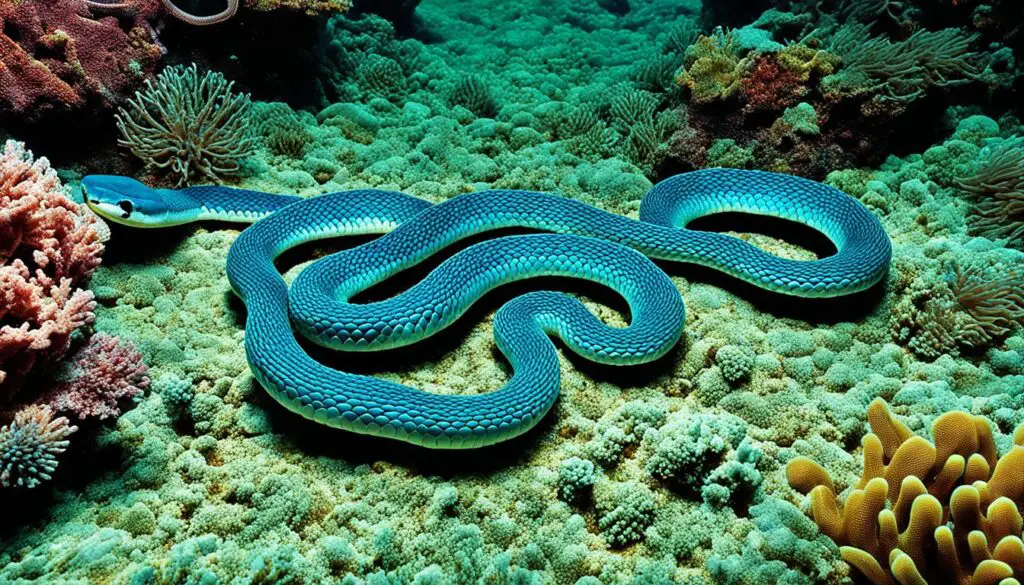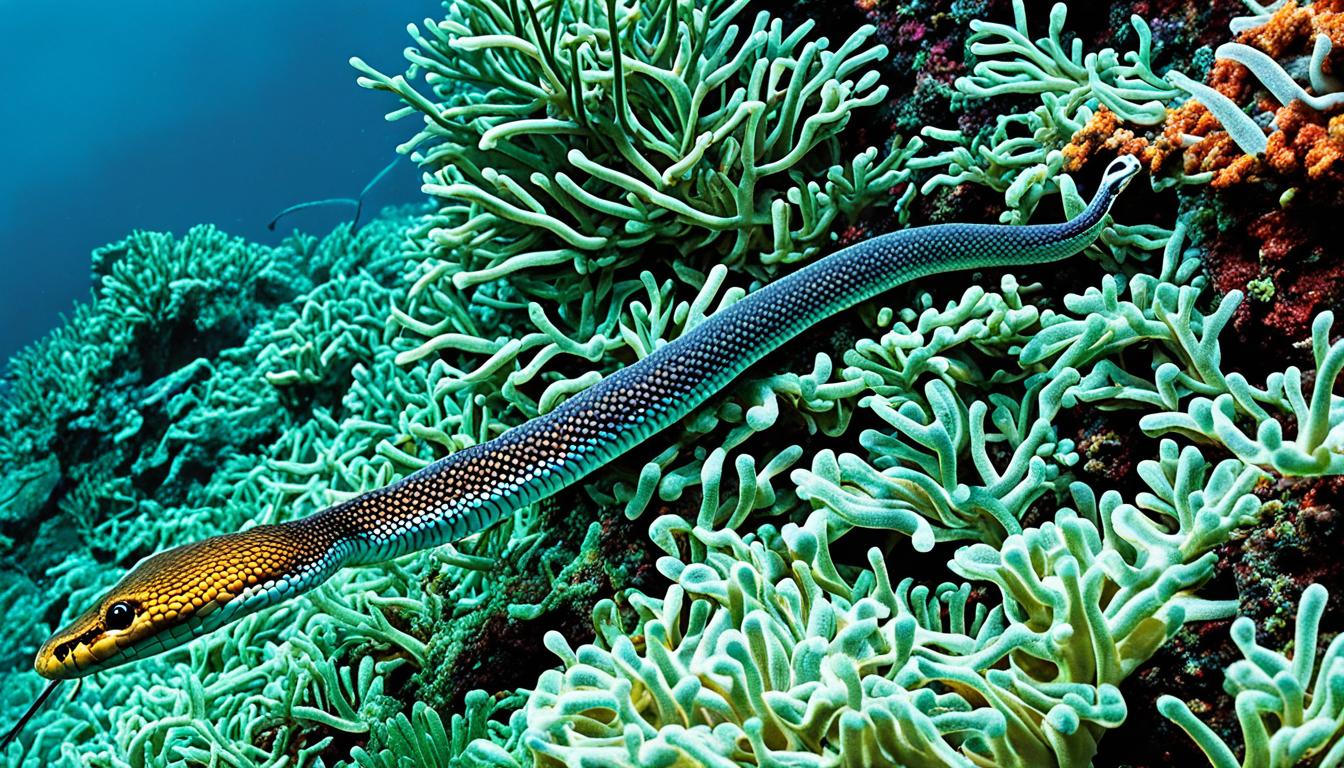Sea snakes are fascinating creatures that live in the ocean. They have caught the attention of many people, making us wonder if they are endangered. To understand this, we need to look at where they live and the threats they face.
Some sea snakes live in warm coastal waters from the Indian Ocean to the Pacific Ocean. However, others like the Leaf-scaled sea snake and the Short-nosed sea snake are in danger. The International Union for Conservation of Nature (IUCN) checks on these species to see if they might go extinct.
This shows how important it is to protect these reptiles. We must learn more about their survival to help them.
Understanding Sea Snakes and Their Habitat
Sea snakes are fascinating creatures that live in diverse marine environments. They are found in tropical and subtropical waters, mainly in the Indian and Pacific Oceans. The distribution of sea snakes is wide, with each species fitting into its own niche. They like shallow coastal areas and estuaries for their food and breeding spots.
Distribution and Preferred Environments
Sea snakes have different habitats. For example, the yellow-bellied sea snake lives from Africa’s coasts to the Gulf of California. They thrive in warm waters. You can find them in:
- Shallow coastal waters
- Estuaries
- Reef systems
- Mangrove swamps
Adaptations to Marine Life
Sea snakes have special adaptations to marine life. Their long bodies and tails help them swim well. They can also breathe through their skin, staying underwater for a long time. These traits help them hunt and survive in the sea.
| Species | Distribution | Habitat Preference | Key Adaptations |
|---|---|---|---|
| Yellow-bellied Sea Snake | Africa to Gulf of California | Shallow coastal waters, estuaries | Paddle-like tail, skin respiration |
| Olive Sea Snake | North Australia, New Guinea | Coral reefs, lagoons | Aquatic locomotion, anti-predator defenses |
| Hispid Sea Snake | Indo-Pacific regions | Seagrass beds, shallow waters | Coloration for camouflage, strong swimming |
Are Sea Snakes Endangered?
Sea snakes are a topic of concern when it comes to their endangered status. Some species are doing well, but others are in danger. The IUCN Red List lists many sea snakes as vulnerable or critically endangered. This is due to human actions and changes in the environment.
The Crocker’s sea snake is one example of a vulnerable species. It faces threats from habitat destruction and fishing bycatch. This shows how human actions affect marine life. The Leaf-scaled sea snake is also declining, highlighting the need to protect sea snakes in our changing world.
Not all sea snakes are in danger, but some are. Climate change and human activities threaten their survival. We need to act to protect these reptiles and their homes.

Conservation Status of Sea Snakes
It’s crucial to understand the sea snake conservation status to protect these unique marine reptiles. The International Union for Conservation of Nature (IUCN) has assessed their status. These assessments help create policies to fight the threats they face.
IUCN Red List Assessments
The IUCN Red List tells us which sea snake species are at risk of extinction. Some species are more at risk than others, which means we need to act fast. Factors like habitat loss, overfishing, and climate change hurt their numbers.
Monitoring Sea Snake Populations
Keeping an eye on sea snake populations is key to their survival. Research helps us understand their numbers, where they live, and their environment. This info helps us make better conservation plans and adapt to new challenges.
| Species | IUCN Status | Major Threats | Conservation Needs |
|---|---|---|---|
| Lapemis curtus | Least Concern | Bycatch, habitat degradation | Population monitoring, habitat protection |
| Hydrophis platurus | Vulnerable | Overfishing, pollution | Research on population structure, stricter fishing regulations |
| Laticauda scutata | Near Threatened | Climate change, habitat loss | Habitat restoration, public awareness initiatives |
Threats to Sea Snakes
Understanding the threats to sea snakes is key to their survival. These threats come mainly from human activities that harm their homes and reduce their numbers. Let’s look at the effects of these actions on these special sea creatures.
Human Activities Impacting Sea Snake Populations
Sea snakes face big dangers from human activities. The main threats are:
- Bycatch in commercial fisheries
- Habitat destruction due to coastal development
- Pollution affecting water quality
- Climate change altering their ecosystems
These threats lead to fewer sea snakes, showing we need to act fast to protect their homes.
Potential Effects of Climate Change
Climate change impact adds more problems for sea snakes. Changes include:
- Rising sea temperatures that change their breeding and eating habits
- Ocean acidification that harms their important habitats
- Changes in food availability, making it harder to survive
These changes upset the balance in the ocean that sea snakes need to live.
Population Decline of Sea Snakes
The decline of sea snakes is a big worry. It shows the big environmental issues we face. One major threat is the bycatch in commercial fishing. Sea snakes often get caught in fishing gear, especially in coastal waters.
This can hurt or kill them, making their numbers go down.
Impact of Bycatch and Fisheries
Bycatch is a big problem for sea snakes. As fishing methods change, sea snakes get caught more often. This not only harms their survival but also affects their role in the ocean.
It’s important to understand this to help sea snakes.
Reproduction and Survival Challenges
Sea snakes also face challenges in reproducing. They have low birth rates, making it hard for their numbers to bounce back. Habitat damage and environmental changes make breeding harder.
Knowing these issues helps us see why we need to act to save these unique sea creatures.
FAQ
Are sea snakes endangered?
Yes, some sea snakes are endangered. The Leaf-scaled and Short-nosed sea snakes are critically endangered. Others are vulnerable. It’s important to know about their conservation status.
What is the conservation status of sea snakes?
The International Union for Conservation of Nature (IUCN) tracks sea snakes through the Red List. This list shows which species are at risk of extinction. Conservation efforts are crucial for those at risk.
Where do sea snakes typically inhabit?
Sea snakes live in warm coastal waters of the Indian and Pacific Oceans. They prefer shallow coastal areas and estuaries. This is where they can live best.
What adaptations do sea snakes have for marine life?
Sea snakes have special traits for living in the sea. They have paddle-like tails for swimming and can breathe through their skin. These help them stay underwater for a long time.
What threats do sea snakes face?
Humans pose a big threat to sea snakes. This includes getting caught in fishing gear, damage to their homes, and pollution. Climate change also harms them by changing sea temperatures and making the ocean more acidic.
How does bycatch impact sea snake populations?
Bycatch in fishing hurts sea snake numbers. Many get caught accidentally in fishing nets. This is a big problem for sea snakes that live close to the coast.
What conservation measures are in place for sea snakes?
To protect sea snakes, we protect their homes, watch their numbers, and make policies. This helps keep their homes safe and fights the threats they face.
How can I contribute to sea snake conservation efforts?
You can help by spreading the word about sea snakes, supporting marine conservation groups, using less plastic, and pushing for sustainable fishing. These actions protect these important sea creatures.







